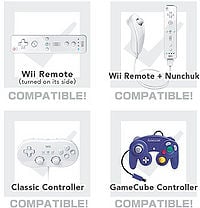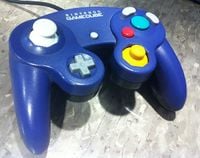Controller

Controllers are used in video games for players to input buttons and other commands. Throughout the Super Smash Bros. series, the games have been compatible with many controllers usable for playing.
Types of controllers
Nintendo 64 controller
This was the first controller to be used in Super Smash Bros.. Due to the fact that only one console is compatible with the controller, the Nintendo 64 controller rarely sees use in tournaments; the resurgence of interest in the original Super Smash Bros. due to emulation also has not caused more interest in the Nintendo 64 controller, as it is difficult to find adapters for the controller, and specific drivers for the adapters can also be difficult to procure.
GameCube controller
For Melee, this was the only controller one could use, barring the use of esoteric adapters for other controllers.
The GameCube controller can also be used as one of the four options of playing Super Smash Bros. Brawl. This option was made for players accustomed to Melee's controls. The release of Super Smash Bros. for the Virtual Console also added the ability to play the game with the GameCube controller. In addition to a standard wired model, a wireless version was released, called the Wavebird; though identical in function, it did not have the rumble capabilities of the original GameCube controller due to battery life concerns. A later revision, produced in white and sporting a 3 metre cord instead of a 2 metre, was also released by Nintendo in April 2008 for Japanese players, and it is mostly associated with Japanese players such as Otori. While difficult to procure in Western territories, some players have imported the controller and use it in tournaments, such as Nairo.
Within Brawl tournaments, the GameCube controller is by far the most popular option, due to the still-strong tournament scene of Melee, the high amount of Melee veterans who have since moved to Brawl, and most players having the opinion of the GameCube controller being the best controller for Smash. Additionally, GameCube controllers do not bring the wireless issues the other available controller types bring, do not carry potential battery issues, are overall simpler to manage (other controller types require batteries and additional attachments), and connecting GameCube controllers to a Wii is considerably simpler and faster than syncing Wii remotes. The Wavebird, however, has not seen frequent use in tournaments, owing to concerns about battery and interference issues; it is also rumoured that the Wavebird is susceptible to lag in its inputs, though no concrete evidence proves this.
While not featuring dedicated ports for the controllers, an adapter produced by Nintendo for the Wii U will allow the use of these controllers with the console; third party options are also available, which instead plug into the Wii Remote.
Wii Remote
The Wii Remote is used on its side, much like an NES controller. In Brawl tournaments, this controller is rarely, if ever used, due to having severe limitations not present in other controllers. Besides having significantly less available buttons and lacking an analog stick to move with, this controller lacks a C-stick equivalent, jumping cannot be relegated to another option other than up on the D-pad, limiting one's aerial mobility and efficiency at performing aerial), up tilts cannot be performed without doing another input previously while holding up on the d-pad (pressing up and attack before jumping will produce an up smash), angling forward tilts and shifting the position of one's shield are impossible, special moves with directional control are harder to maneuver, such as Fire Fox and PK Thunder, and it is impossible to perform a DACUS or boost grab.
Due to the Wii U's backward compatibility with Wii games, the Wii Remote and all variations below can be used on the Wii U when Brawl is run; furthermore, it has been stated by Masahiro Sakurai that the Wii Remote and all of its variants will be available for use in Super Smash Bros. for Wii U.
Wii Remote with Nunchuk
The Nunchuk is inserted into the bottom of the Wii remote for games too complex for the Remote alone. Movement is assigned to the Nunchuk's control stick, while A and B button attacks are assigned to the standard attacks and special attacks respectively, with grabbing performed by pressing A and B together. By default, taunts are assigned to combinations of the 1 and 2 buttons. This controller is commonly referred to as the "Wiichuk", as a simpler name that differentiates it from the Wii Remote alone.
The majority of players believe the GameCube controller to be superior to the Wiichuk. Despite this, the Wiichuk has near-equivalent capabilities compared to the GameCube controller. For objective disadvantages, the Wiichuk lacks access to B-sticking and A-sticking, as well as having less available buttons. The Wiichuk does have a couple of advantages however; the ability to assign smash attacks to buttons, rather than assigning them to an analog stick, gives the Wiichuk superior capability to mash out of grabs, and it has access to the unique shake smash.
Classic Controller
Classic Controllers were initially released for the Wii's Virtual Console, though this later changed when the Wii's library began to grow, with some games later choosing to use the controller as a method of gameplay controller. After Brawl's release, an updated version, the Classic Controller Pro, added "wings" to the controller and made its profile thicker. As the controller connects to the Wii Remote, it is wireless in nature.
Despite being near functionally identical to a GameCube controller with an added shoulder button, the Classic Controller is not used often in tournaments. Besides most players preferring the design of the GameCube controller, this can be attributed to the Classic Controller having potential connectivity and interference issues that come with wireless controllers, and that the Classic Controller effectively requires the player to bring along batteries and a Wiimote to use it. There are also claims that the Classic Controller is less durable than official GameCube controllers, thus requiring players to have to spend more money to obtain more replacement controllers to continue optimally playing. Despite this, some players chiefly use the Classic Controller in tournaments, such as Vermanubis.
Nintendo 3DS
The Nintendo 3DS is a handheld console, and as such, its controller is a built-in part of its design. By necessity, it is effectively the only usable controller in the 3DS version of Super Smash Bros. 4. Its button layout is similar to the Classic Controller, except it only has two shoulder buttons and lacks a second analog stick.
A later hardware revision of the console, the New Nintendo 3DS, adds a small, secondary analog nub to the console, as well as two extra shoulder buttons for a total of four; while such functionality is available for the standard 3DS via the Circle Pad Pro accessory, Super Smash Bros. 4 cannot support the accessory due to technical limitations involving how the Nintendo 3DS runs Smash 4.
The Nintendo 3DS can potentially be used as a controller for the Wii U version, as part of the compatibility between the two versions, and the controls are kept identical. In addition to its use as a controller, linking the two games together allows players to potentially transfer customised characters between the two consoles.
Modified controllers
Within the tournament scene, the use of modified controllers (sometimes called "Frankencontrollers" after the famous literary character) became a small, niche trend. Exact modifications can be separated into two categories: cosmetic, and functional.
Cosmetic mods focus on changing the physical appearance of the controller, such as by recolouring the casing or merging two different shells together to form a two-toned controller. Although rarer, other methods of cosmetic changes can also involve placing LEDs into the casing or changing the physical appearance of individual buttons.
Functional mods involve physically altering either the two analogue sticks or the individual buttons. For the analogue sticks, common mods focus on replacing worn-down sticks with those from an identical controller, or from other controllers, such as from the Nunchuk or even DualShock controllers. In addition, Brawl players can choose to remove the springs from the L and R due to the game not recognising light button presses. Finally, other mods involve completely severing the rumble from the controller, thus decreasing controller weight and preventing the need to constantly have to switch rumble off.
Computer keyboard
When emulated through the use of a computer, standard computer keyboards have seen use by users of the emulators Project 64 and Dolphin. While having flaws of its own compared to official controlling methods, computer keyboards offer some interesting benefits.
Although a rare sight at tournaments, the use of keyboards is not completely unheard of; a particularly well-known event in the tournament Zenith 2013 featured SuPeRbOoMfAn using a keyboard against Sensei in the grand finals.
In tournament play
Within tournaments, controllers are rarely provided to players; as a result, the phrase BYOC became common, meaning "Bring Your Own Controller". Players are responsible for their own controllers, as tournaments will not replace them or compensate players who lose them.
Within the Brawl and Project M tournament scenes, GameCube controllers are ubiquitous, though a few players are dedicated to using the Wiichuk or Classic Controller.
Due to the wireless nature of Wii Remotes, Wii Remotes are required to have their batteries removed between matches, as they can interfere with other remotes trying to sync to the console, as well as with connecting GameCube controllers; players who do not comply can be disqualified. The Wavebird is also generally banned in large-scale events; the controller allows for only twenty potential channels between it and its dongle, and a large amount of such controllers can potentially lead to interference issues between different players at different setups. Third-party controllers are usually allowed, but those which include turbo or macro buttons are banned, as they can provide an unfair advantage in regards to button mashing and other techniques.
The decision of whether or not modified controllers should be banned or not is up to the discretion of the tournament organiser, though a ban does not necessarily have to be black-and-white; some tournaments, for instance, may allow some mods, but ban others, and others still might allow strictly cosmetic mods, but not functional mods.
Controller compatibility chart
| SSB (Nintendo 64) | SSBM (Nintendo GameCube) | SSBB (Wii) | SSB4 (3DS) | SSB4 (Wii U) | |
| Nintendo 64 Controller | |||||
| GameCube controller | |||||
| Wii Remote | |||||
| Wii Remote & Nunchuk | |||||
| Classic Controller | |||||
| Wii U GamePad | |||||
| Wii U Pro Controller | |||||
| Nintendo 3DS |
References
| Controllers and buttons | |
|---|---|
| Nintendo 64 controller | |
| GameCube controller | |
| Wii Remote (and Nunchuk) | |
| Classic Controller | L |
| Nintendo 3DS | |
| Wii U GamePad / Pro Controller | L |
| Joy-Con | |
| Switch Pro Controller | L |
| Third-party controllers | Hori Mini Pad · Arcade controller · Keyboard |
| Other | Smash Controller · Controller modification |

